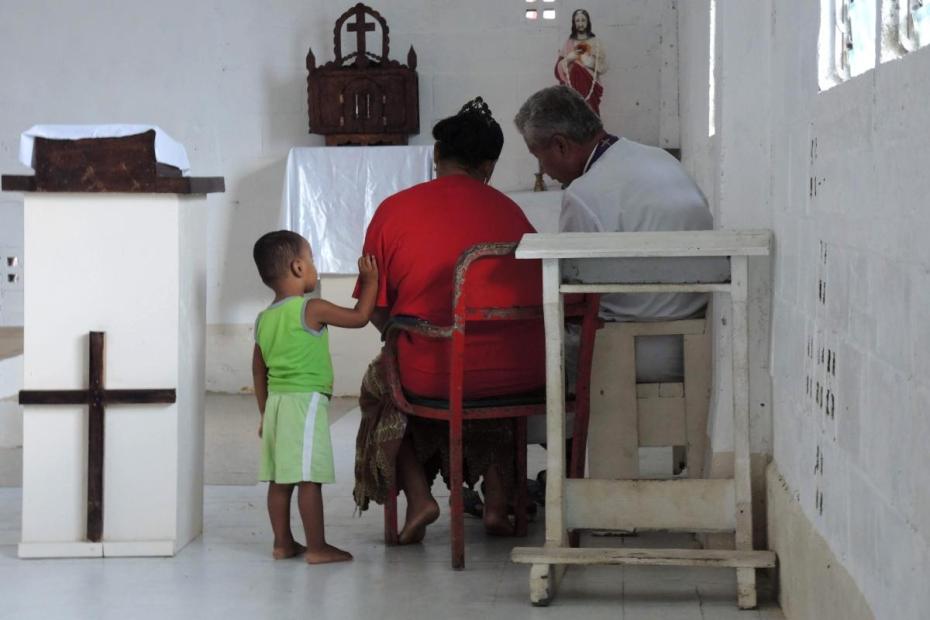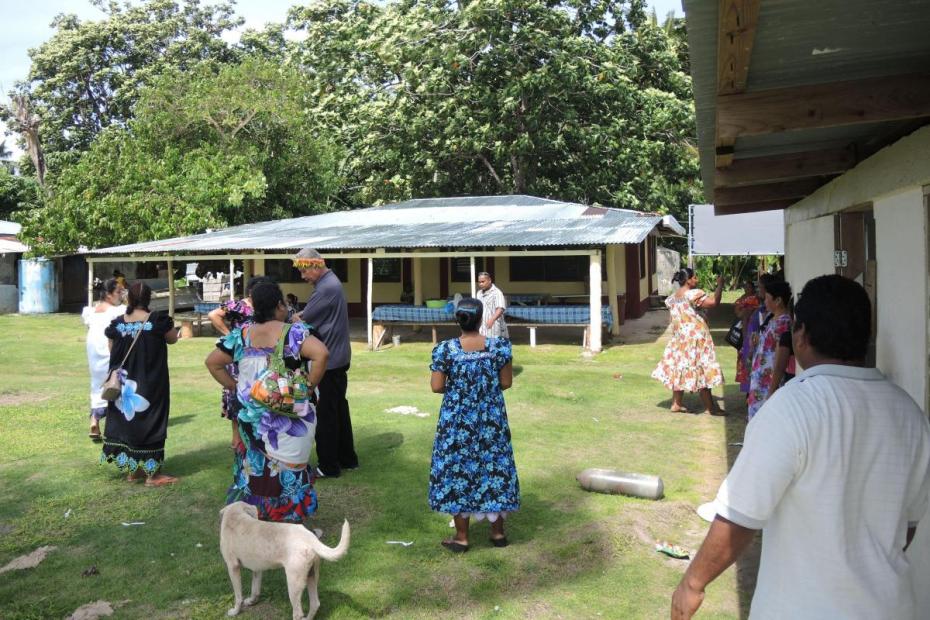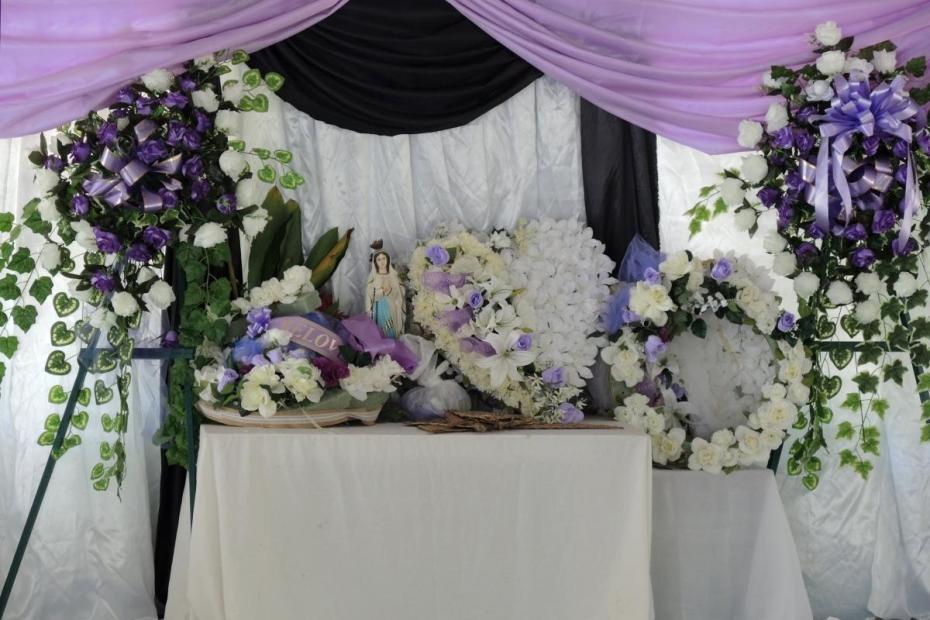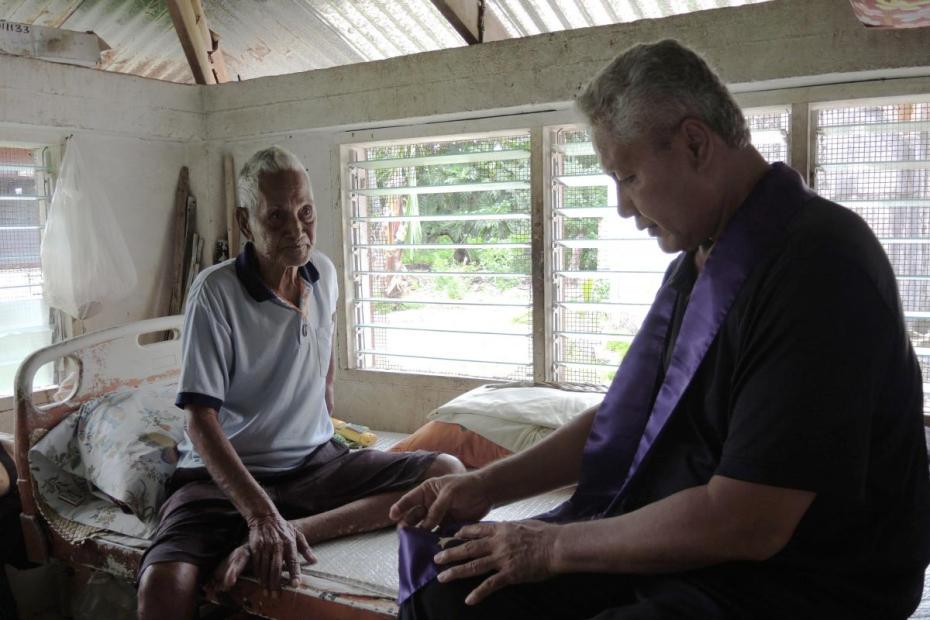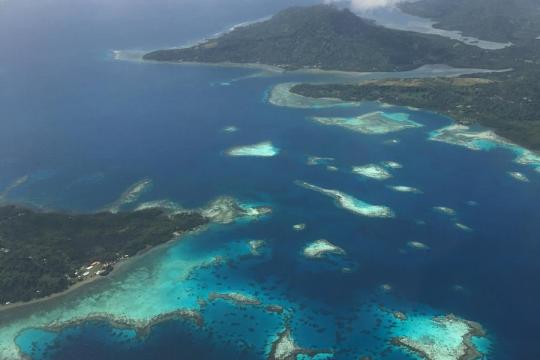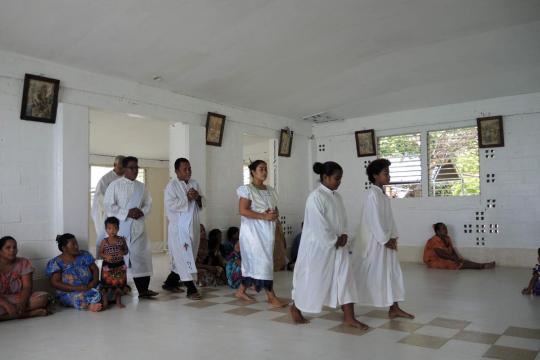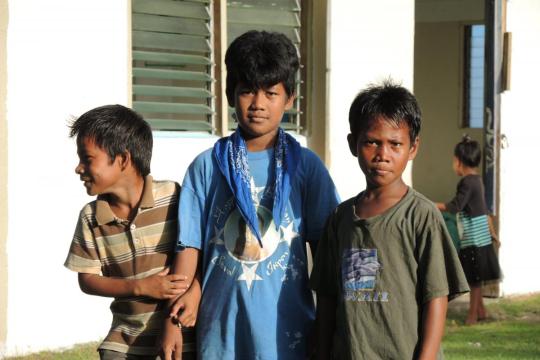The articles about Chuuk on this website emphasize the degree to which respect is a decisive value shaping Chuukese culture, including in the family. People are expected to surrender many of their own needs to the needs of the whole community, and to abide by the decisions of the community. “The people of Chuuk... speak with disdain of a philosophy that emphasized what one is entitled to receive (rights) instead of what one is obligated to give (responsibilities)... In their minds, a code of social justice that was built on rights ran the risk of condoning irresponsibility.” Responsibilities are more important than rights, according to Chuukese people, because rights clash, whereas responsibility enables consensus.1
Respect and consensus are core cultural values, but that’s not to say that there are never violations of these sort of norms. Like all humans, Chuukese fail at times—sometimes even spectacularly so—to live up to their responsibilities. Chuuk has some especially notable rituals to achieve reconciliation and restore good order in the aftermath of violations.
Three phenomena encountered in the course of this research—well-attended Advent and Lenten reconciliation services; a culturally important family reconciliation ritual that is incorporated into funeral novenas; and a traditional, communal practice of reconciliation in the aftermath of violence—suggest how important reconciliation is in Chuukese culture.
The role of reconciliation in church settings does not require too much attention here, except to say that reconciliation services drew significant crowds in village settings, a fact that stands out compared to many parts of the world. While individual confession was part of the service (and the pastor made sure to visit those who were too sick to come to the church) the service was very much communal. Villagers had the opportunity to see who was there, and to pray together, not only individually, for forgiveness. A video of one service, on the island of Fono, is on this page.
Reconciliation among the living is also built into the process of grieving the dead. Catholics mourn the dead for nine nights, praying the Rosary and gathering around the body. There is an opportunity during this time to say what the deceased meant to people, but beyond that, the mourners “take the occasion to speak about grievances and hurts done to each other, to apologize,” one woman explained. The process is ritualized, not incidental, and takes the form of speeches that people consider beforehand. If there are cleavages and hurts that have developed in the family or the community, this is the time that they need to be repaired. People take turns speaking, another said, not about the qualities of the deceased, but “about working together… the speeches are more focused on re-affirming or relationship, and some will speak about getting closer to God. Some will just talk about ways to keep our family together.”
Reconciliation in the face of violence
The rituals that Chuukese people use to achieve justice and reconciliation in the aftermath of violence are so remarkable, so unlike what happens in many other cultures, that they are worth explaining in more detail.
Interviewees acknowledged that the harmony that characterizes daily life in Chuuk is sometimes quickly shattered under the influence of alcohol.2 Alcohol, a colonial import, was identified as a primary source of social instability in the islands. Young men sometimes drink to great excess, and under the influence commit crimes that are unimaginable in normal circumstances. Knifings tend to be the most extreme result.
How the families deal with such crimes is what’s most remarkable.3 As interviewees recounted it, in Chuuk, when someone commits a crime—even a murder—the matter is something that whole families (i.e. lineages) have to settle. Civil courts, interviewees reported, almost always defer to this inter-family system of justice.
The system was described this way: in the aftermath of a serious crime, say, a killing, the extended family of the person who has caused the harm gathers together near the compound of the offended family.4 “Once they are close to the place, they will start to crawl on their knees.... even on the tarmac they will crawl [this a sign of respect, remorse, and the purpose of their visit] until somebody [from the other family] tells them to get up.” They “bring a lot of things with them like local food.” If they are not told to get up, they know to leave, that the time is not yet right. Eventually, the other family is expected to receive them, and a process of reconciliation and negotiation for amends begins. Over time, the lineages talk about what the offending family needs to give up to make adequate amends. If it is serious enough, the victim’s family “would ask [the offender’s family] to give land,” which is traditionally the most prized and limited possession on the island, in return for the suffering they caused. Whether through giving their food or land, family of the offender pays a price to the family of the victim. “Some even give a child” for adoption as a member into the new family. Or the offender himself can even be given for adoption into the family of the victim. “It happened in my family, reported another man. “Somebody… got drunk and stabbed a guy to death.” The other “family went and they apologized… the one that stabbed him, the family said, ‘Now he can come as a replacement of your son.’”
The notion that the family of the perpetrator would give the offended family a child “for adoption” would seem to many outsiders puzzling and even cruel. But traditional adoption in Chuuk is additive, not exclusive. The child “offered” does not cease to be part of his or her family of origin, but is additionally part of the offended family. The idea that a family whose son was killed might adopt the killer into their family “in place of” the dead son is similarly startling. All of this, I was told, was a way of assuring that the two families’ future was sealed together moving forward as a shared endeavor. It was a way of ending cycles of vengeance by giving both families a common future. The offending individual would be expected to provide help for the offended family whenever called upon, just as a son would. The man who reported that this happened in his own family said of the killer, “we can call him to help, or he would just go to help… now if we see him, he’s like a brother now.” Becoming a brother does not mean entering into a casual relationship of easy friendship. It means that the men are permanently in a relationship of respect and authority that is inviolable, and that the brother is expected to help the family when called upon.5
Courts can step in, and victims can opt for a trial, but if families work out a solution, as normally happens, courts defer to the families. In the instance described above, the offender was jailed by the courts for a few months while the matter was being settled, but then was released. Catholic priests in Chuuk described being ready to step in to help facilitate this process.
What religion is for
A young man of Chuukese heritage, raised on Guam and working extensively there with recently emigrated Chuukese youth, expressed his puzzlement about an aspect of Chuukese life in a way that may be insightful about Chuukese Catholicism. He argued that alcohol had caused huge problems in his community: “If no alcohol, then no fighting, no family problems.” Then he said, when they are drunk, “a lot of them get stabbed, they have this thing about stabbing each other. But they’re religious. They’re so religious. They come to church…but then they leave the church and it’s like they didn’t learn anything…Not only Catholics. There’s other churches. They’re so faithful, but the next day they are back to themselves. It’s like, what happened to what you learned yesterday at the service and the homilies? They go to church and they learn how to better themselves, but they don’t use that practice the whole week.”
The young man himself has a foot in two cultures, one more Chuukese and one more Americanized. His question, perfectly reasonable, reflected the latter. Implicit in his dilemma is the belief that Catholicism “works” insofar as it changes individuals and makes them better.6 This is consistent with the Gospels. Chuukese certainly do look to Catholicism to make them better. They have strong indigenous cultural mechanisms to do that in ordinary life. As Juliana Flinn observed in the Chuukese Outer Island of Pulap, “Local belief posits power in speech and its ability to define and shape appropriate behavior.” That’s why people give speeches at funeral novenas.7 But the tension that this man observed is real as well.
Even so, for Chuukese, a particular attraction of Christianity, including Catholicism, may well be the way it helps reconcile and reinforce community.
To what extent the cultural value placed on reconciliation is Catholic or traditional is difficult to determine, and perhaps beside the point.
Early accounts by foreigners describe the islands as rent by conflict. Early missionaries claimed that “Chuukese… were vindictive when offended in the quarrels that were constantly breaking out over food, women or land. Their violent response prompted quick retaliation from the offended side and hostilities soon escalated because there was no chief with the power to intervene… Warfare was simply a chronic condition for an area divided into small estates or districts.”8 Jay Dobbin does not list reconciliation as a particular characteristic of pre-Christian Chuukic religion. “The only reconciliation ritual I know of is the pounding and offering of sakau on Pohnpei [a Micronesian island far from Chuuk], a rite now incorporated into the Roman Catholic sacrament of penance.”9 Hezel suggests that forgiveness is a resource that came from Christianity, so that the example of the Gospel helped end a variety of inter-family and inter-village rivalries.10
Though they in very many ways embody Christian ideals of reconciliation and forgiveness, the rituals of inter-family reconciliation in the face of violence were described by interviewees as “traditional” practices, not Catholic or Christian ones (the practice is common to Protestants and Catholics alike on Chuuk). So too are the reconciliation speeches at funeral novenas. The category of the “traditional” should not be understood as something static that was passed down from before the European influence. Inevitably, Christian religious beliefs reshaped whatever practices of this sort might have existed before.
In the young man’s puzzled account, it seems hard to believe that people come to church to provide cover to ignore the message, but they do come back in part to heal and reconcile. Their culture and circumstance may make reconciliation more central to their understanding of the Catholicism than in most places in the world. The desire to achieve reconciliation, to bring people together—so highly valued culturally—impacts what people expect out of religion, what it is “for.”
In her study of the people of Pulap, Flinn concluded as much: “In general, religion—specifically Catholicism—is seen as a force that can aid in keeping the peace, and in fact part of the job of religion is to help maintain harmonious relations among people.”11 Interviewees for this research said similar things. During part of an interview that discussed funeral practices and old beliefs about the presence of dead spirits, “Jean,” a Chuukese woman explained the purpose of the reconciliation of mourners with the dead and each other at a funeral service in stark terms: “It wasn't for the sake of the spirits, it was for the sake of the community.”
Another simply commented that the funeral reconciliation “really brings people together.” One young man made a surprisingly functionalist argument that captured a dual tension: “We’re very religious persons. We always look for these religious events that really bring us together. It’s our way to resolve some of our social problems. We use religions as a tool.”
- 1Francis X. Hezel, S.J., Making Sense of Micronesia: The Logic of Pacific Island Culture (Honolulu, University of Hawai’i Press, 2013), 47.
- 2Francis X. Hezel, S.J., has written a helpful overview on the impact of alcohol in all of Micronesia, with statistics on each state, and some analysis of its impact. http://www.micsem.org/pubs/articles/alcodrug/alcfsm/frames/alcfsmfr.htm.
- 3The descriptions here derive from interviews with a number of Chuukese on Guam and Weno during research in 2017 and 2018, and conversations with Francis Hezel, S.J.
- 4As the webpage on family indicates, the maternal lineage group is the traditional family grouping. This is a much more extended group than the “nuclear” family, but for convenience, the word family is employed here.
- 5Casual readers may misinterpret what it means to be a brother. The role is permanent and enduring, and requires respect. It is not a matter of becoming buddies. As the section on family notes, “Brothers owe great deference to each other, which puts them in relationships that can never be casual and informal.” See Francis X. Hezel, S.J., Making Sense of Micronesia: the Logic of Pacific Island Culture (Honolulu: University of Hawai’i, 2013), 89.
- 6My reflection on this perspective here derives in part from one aspect of the “moralistic therapeutic deism” that Smith and Denton intuited in American teenagers. Christian Smith, with Melinda Lundquist Denton, Soul Searching: The Religious and Spiritual Lives of American Teenagers (Oxford University Press, 2005), 163.
- 7Juliana Flinn, Mary, the Devil, and Taro: Catholicism and Women's Work in a Micronesian Society (Honolulu: University of Hawai'i Press, 2010), 5.
- 8Francis X. Hezel, S.J., Strangers in their Own Land: A Century of Colonial Rule in the Caroline and Marshall Islands (Honolulu, University of Hawai’i Press, 1995), 65.
- 9Jay D. Dobbin, Summoning the Powers Beyond: Traditional religions in Micronesia (Honolulu: University of Hawaiʻi Press, 2011), 20.
- 10Francis X. Hezel, S.J., “Christianity in Micronesia: The Interplay between Church and Culture” in Introducing World Christianity, ed. Charles E. Farhadian (Blackwell, 2012), 239.
- 11 Flinn, Mary, the Devil, and Taro, 52.
